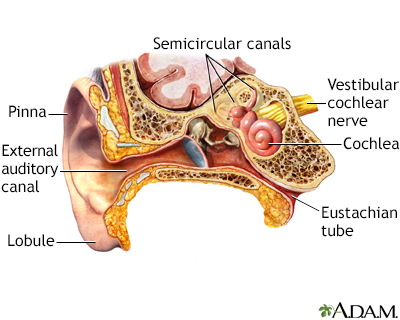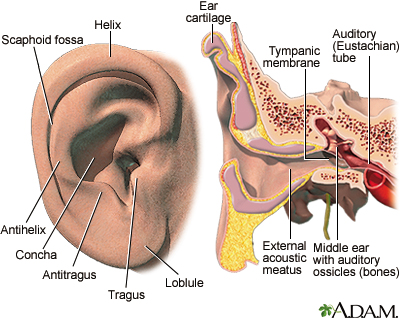Ear - blocked at high altitudes
High altitudes and blocked ears; Flying and blocked ears; Eustachian tube dysfunction - high altitude
The air pressure outside of your body changes as altitude changes. This creates a difference in pressure on the two sides of the eardrum. You may feel pressure and blockage in the ears as a result.
Images



I Would Like to Learn About:
Information
The eustachian tube is a connection between the middle ear (the space deep to the eardrum) and the back of the nose and upper throat. This structure connects the middle ear space to the outside world.
Swallowing or yawning opens the eustachian tube and allows air to flow into or out of the middle ear. This helps equalize pressure on either side of the eardrum.
Swallowing or yawning can unclog blocked ears when you are going up or coming down from high altitudes. Chewing gum the entire time you are changing altitudes helps by causing you to swallow often. This may prevent your ears from getting blocked.
People who always have blocked ears when flying may want to take a decongestant about an hour before the flight leaves.
If your ears are blocked, you can try breathing in, then gently breathing out while holding your nostrils and mouth closed. Use care when doing this. If you breathe out too forcefully, you can cause ear infections by forcing bacteria into your ear canals. You can also create a hole (perforation) in your eardrum if you blow too hard.
References
Peak DA. Scuba diving and dysbarism. In: Walls RM, Hockberger RS, Gausche-Hill M, eds. Rosen's Emergency Medicine: Concepts and Clinical Practice. 10th ed. Philadelphia, PA: Elsevier; 2023:chap 131.
Van Hoesen KB, Lang MA. Diving medicine. In: Auerbach PS, Cushing TA, Harris NS, eds. Auerbach's Wilderness Medicine. 7th ed. Philadelphia, PA: Elsevier; 2017:chap 71.
BACK TO TOPReview Date: 5/30/2022
Reviewed By: Josef Shargorodsky, MD, MPH, Johns Hopkins University School of Medicine, Baltimore, MD. Also reviewed by David C. Dugdale, MD, Medical Director, Brenda Conaway, Editorial Director, and the A.D.A.M. Editorial team.

Health Content Provider
06/01/2025
|
A.D.A.M., Inc. is accredited by URAC, for Health Content Provider (www.urac.org). URAC's accreditation program is an independent audit to verify that A.D.A.M. follows rigorous standards of quality and accountability. A.D.A.M. is among the first to achieve this important distinction for online health information and services. Learn more about A.D.A.M.'s editorial policy, editorial process and privacy policy. A.D.A.M. is also a founding member of Hi-Ethics. This site complied with the HONcode standard for trustworthy health information from 1995 to 2022, after which HON (Health On the Net, a not-for-profit organization that promoted transparent and reliable health information online) was discontinued. |
The information provided herein should not be used during any medical emergency or for the diagnosis or treatment of any medical condition. A licensed medical professional should be consulted for diagnosis and treatment of any and all medical conditions. Links to other sites are provided for information only -- they do not constitute endorsements of those other sites. © 1997- 2024 A.D.A.M., a business unit of Ebix, Inc. Any duplication or distribution of the information contained herein is strictly prohibited.
